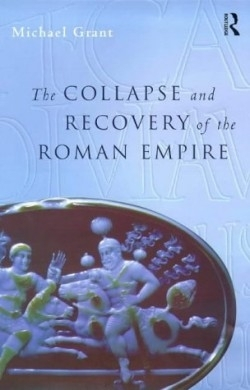The Collapse and Recovery of the Roman Empire
In his concise account of the fifty-year crisis (AD 235-285) that threatened the Roman Empire’s survival, Grant concentrates on three factors: weak, short-lived emperors imposed, deposed, and murdered by the military; invasions by Germanic tribes; and the loss of eastern territories to the Persians. In the empire’s recovery, Grant focuses on stronger emperors who reorganized the imperial army, on the benefits of a more stable currency and on the unity-promoting but short-lived effects of imported sun-worship. Brief chapters suggest Heliodorus? splendid novel The Aethiopica provided weary Romans with an escape from political and economic travails and that Plotinus? philosophy and Mani’s religious creed provided additional solace. An appendix provides an informal personal assessment of Graeco-Roman civilization.
For well-informed readers, Grant provides a useful, fact-filled summary of the often disastrous events occurring between Alexander Severus? death in 235 and Diocletian’s accession in 284. Less well-informed readers will find themselves plunged in medias res, in a welter of names, places and events. This book needs an introduction sketching the empire’s mid-third century political, military, social and economic status; the failure of the adoptive and dynastic systems of succession to the imperial office; the tension between the Senate in Rome and emperors in the field; and the logistics of military defense and attack. The changing financial capacity and taxation systems of the empire, its diplomatic and commercial relations with the non-Roman world and popular expectations about peace and prosperity also need more discussion.
As Grant himself suggests, this book may be seen as something of a patchwork. It is. In places choppy and abrupt, it shows signs of hurried preparation. Bone and sinew abound, flesh is sometimes lacking. On the plus side, Grant presents a gallery of unforgettable characters, among them emperor Philip, slain in battle, and Valerian, captured by Sapor I of Persia and known to posterity as the Roman emperor who became the slave of a Persian king. Illustrations of striking busts of the middle-aged emperors Philip and Decius as worried CEOs and a younger Gallienus as determination incarnate seize the reader’s imagination, as do fine examples of coin portraits as propaganda. The notes, bibliography and source listings will benefit any reader. In these, Grant is at his best, a seasoned classical historian opening the door to rich resources, including the inexhaustible goldmine of The Oxford Classical Dictionary (3rd edition, 1996).
Reviewed by
Peter Skinner
Disclosure: This article is not an endorsement, but a review. The publisher of this book provided free copies of the book to have their book reviewed by a professional reviewer. No fee was paid by the publisher for this review. Foreword Reviews only recommends books that we love. Foreword Magazine, Inc. is disclosing this in accordance with the Federal Trade Commission’s 16 CFR, Part 255.

